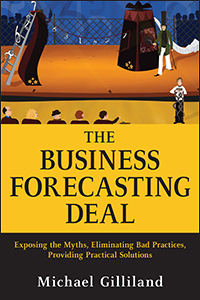
In the first of two posts spotlighting SAS R&D innovators, SAS' Udo Sglavo introduces you to developers Amy Shi, Maggie Du and Phil Helmkamp.

In the first of two posts spotlighting SAS R&D innovators, SAS' Udo Sglavo introduces you to developers Amy Shi, Maggie Du and Phil Helmkamp.

So you think you are smarter than the average forecaster, and can identify a trend in time series data? You now have a chance to put your trend detection skills (aka trendar) to the test, and help the cause of forecasting research in the process. Nikos Kourentzes, Associate Professor at

To properly evaluate (and improve) forecasting performance, we recommend our customers use a methodology called Forecast Value Added (FVA) analysis. FVA lets you identify forecasting process waste (activities that are failing to improve the forecast, or are even making it worse). The objective is to help the organization generate forecasts

Aphorism 3: Organizational Policies and Politics Can Have a Significant Impact on Forecasting Effectiveness We just saw how demand volatility reduces forecastability. Yet our sales, marketing, and financial incentives are usually designed to add volatility. We reward sales spikes and record weeks, rather than smooth, stable, predictable growth. The forecast

You may not be in London on October 7 to take advantage of the Lancaster Centre for Forecasting's free workshop on promotional forecasting. However, there are still plenty of forecasting educational opportunities coming up this fall: SAS Business Knowledge Series Best Practices in Demand-Driven Forecasting (Chicago, September 24-25) My colleague

As discussed in the last BFD post, sometimes a difficult and expensive problem doesn't have to be solved -- it can simply be avoided. When the teetering boulder threatened the baby below the cliff, we removed the baby and no longer had to worry about propping up the boulder. When it

The BFD blog probably won't make you the best forecaster you can be. There are plenty of books and articles and world class forecasting researchers (many of them meeting next week in Rotterdam at the International Symposium on Forecasting), that can teach you the most sophisticated techniques to squeeze every last

As we saw last time with Steve Morlidge's analysis of the M3 data, forecasts produced by experts under controlled conditions with no difficult-to-forecast series still failed to beat a naive forecast 30% of the time. So how bad could it be for real-life practitioners forecasting real-life industrial data? In two words:

A recurring question among business forecasters is how to incorporate input from the sales force. We discussed this last year in The BFD post "Role of the sales force in forecasting." But the question came up again this week in the Institute of Business Forecasting discussion group on LinkedIn, where

With this Q&A Part 3, we are about halfway through the questions submitted during the FVA webinar. We did over 15 minutes of live Q&A at the end of the webinar, and covered many of the submitted questions at that time, however I always prefer to issue complete written responses to

There is a well recognized phenomenon that combining forecasts, derived from different methods using different sources of information, can improve forecast accuracy. This approach, sometimes called "ensemble forecasting," is available in SAS Forecast Server. Per Scott Armstrong's review of 57 studies on combining forecasts, "the combined forecast can be better

Some ideas sound great (combining chocolate with peanut butter) and turn out great (Reese's Peanut Butter Cup). Some ideas sound great (getting a face lift) but turn out bad (Kenny Rogers, Greta Van Susteren). Some ideas sound bad (a Run-DMC / Aerosmith duet) but turn out great ("Walk This Way"). Some ideas sound bad (letting

Have you noticed the annoying stock art they put on The BFD blog header? All I can think of is "If those idiots only used SAS Forecast Server, they wouldn't have to draw graphs all over their window panes just to do forecasting." It must really p.o. the housekeeping staff at that